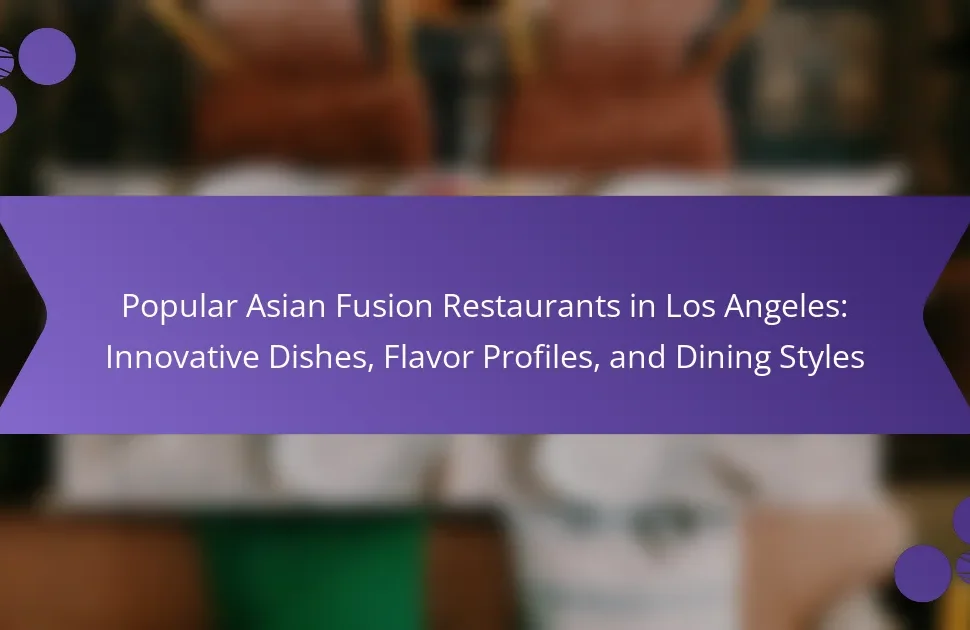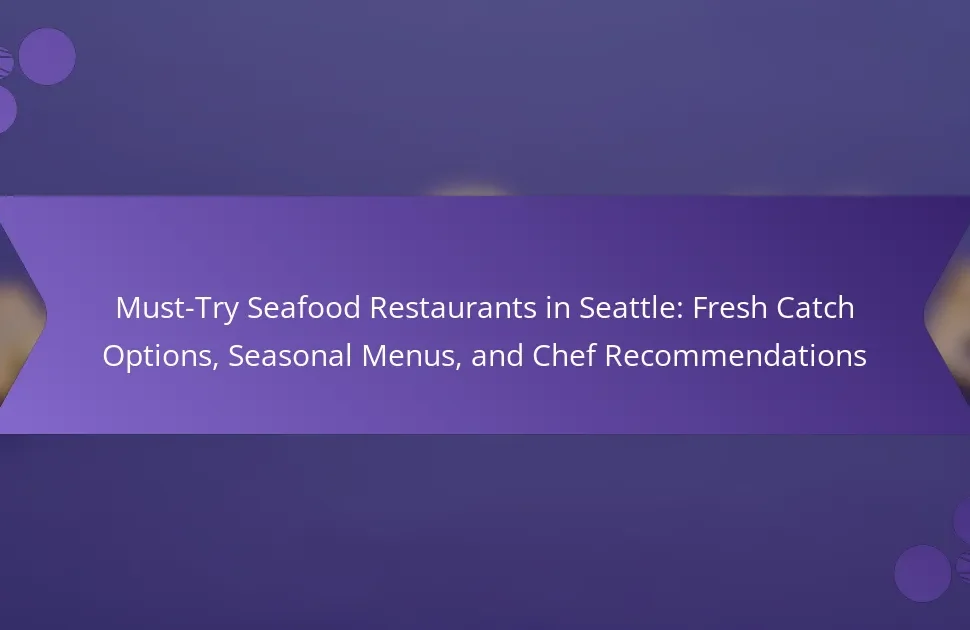
What are the Best Fine Dining Experiences in Las Vegas?
The best fine dining experiences in Las Vegas include Joël Robuchon, Le Cirque, and Twist by Pierre Gagnaire. Joël Robuchon offers exquisite French cuisine with a focus on seasonal ingredients. Le Cirque features a vibrant atmosphere and classic French dishes. Twist by Pierre Gagnaire presents innovative French cuisine with a unique twist. These restaurants are consistently praised for their exceptional service and culinary artistry. They have received prestigious awards, including Michelin stars. Each dining experience showcases the culinary talent of renowned chefs. Las Vegas is known for its luxurious dining options, attracting food enthusiasts from around the world.
How do fine dining experiences in Las Vegas stand out?
Fine dining experiences in Las Vegas stand out due to their unique blend of gourmet cuisine, exceptional service, and luxurious ambiance. Renowned chefs create innovative menus that often feature locally sourced ingredients. Many restaurants offer exclusive dishes that reflect culinary artistry. The atmosphere is meticulously designed, enhancing the overall dining experience. High-end establishments often include personalized service, ensuring guests feel valued. Additionally, Las Vegas fine dining frequently incorporates entertainment elements, making meals memorable. The city’s diverse culinary scene also allows for a wide range of international flavors. With accolades from prestigious awards, these dining experiences are recognized for their excellence.
What unique attributes define fine dining in Las Vegas?
Unique attributes of fine dining in Las Vegas include exceptional culinary innovation, opulent ambiance, and renowned chefs. Culinary innovation is evident in the diverse and unique menus offered by various establishments. Many restaurants feature dishes that blend international flavors with local ingredients. The ambiance is characterized by luxurious decor, often with stunning views of the Las Vegas Strip. Renowned chefs, such as Gordon Ramsay and Joël Robuchon, elevate the dining experience with their expertise. Exclusive dining experiences, like chef’s tables and tasting menus, are common. The city also hosts prestigious culinary events, showcasing the best in fine dining. High-quality service is a standard expectation, ensuring a memorable experience for guests.
How do the locations contribute to the dining experience?
Locations significantly enhance the dining experience by providing unique atmospheres and aesthetics. Fine dining establishments in Las Vegas often feature opulent decor, which creates a luxurious ambiance. The view from these locations can also play a crucial role, as many restaurants offer stunning vistas of the Las Vegas Strip or surrounding landscapes.
Additionally, the geographical context contributes to the overall experience. For instance, restaurants situated in iconic hotels or near cultural landmarks attract guests seeking a complete experience. The accessibility of these locations adds convenience, making it easier for diners to enjoy their meals.
Furthermore, the social setting of a location can influence the mood and interaction among diners. High-end locations often attract a diverse clientele, enhancing the social experience. Overall, the combination of atmosphere, views, geographical context, accessibility, and social setting collectively enriches the dining experience in Las Vegas.
What types of gourmet menus can be found in Las Vegas?
Las Vegas offers a variety of gourmet menus that cater to diverse culinary preferences. High-end restaurants feature French, Italian, Asian, and American cuisines. Many establishments present chef’s tasting menus for an exquisite multi-course experience. Seasonal menus highlight fresh, local ingredients and innovative dishes. Specialty menus often include vegan, vegetarian, and gluten-free options. Celebrity chef restaurants provide signature dishes that showcase their unique styles. Wine pairings are commonly offered to enhance the dining experience. Overall, the gourmet dining scene in Las Vegas is celebrated for its creativity and quality.
What are the most popular cuisines offered in fine dining?
The most popular cuisines offered in fine dining include French, Italian, Japanese, and Mediterranean. French cuisine is renowned for its elegance and technique, featuring dishes like coq au vin and soufflés. Italian cuisine emphasizes fresh ingredients and flavors, showcasing pasta and risotto. Japanese cuisine is celebrated for its precision and presentation, with sushi and kaiseki being prime examples. Mediterranean cuisine offers a variety of dishes rich in vegetables, grains, and seafood, often highlighting flavors from countries like Greece and Spain. These cuisines are frequently featured in high-end restaurants due to their culinary traditions and global appeal.
How do seasonal menus enhance the dining experience?
Seasonal menus enhance the dining experience by providing fresh, high-quality ingredients. These menus reflect the peak flavors of each season. Diners enjoy unique dishes that change throughout the year. This variety keeps the dining experience exciting and engaging. Seasonal menus often highlight local produce, supporting regional farmers. Research shows that fresh ingredients can improve taste and nutritional value. For example, a study published in the Journal of Culinary Science & Technology indicates that seasonal produce has higher flavor profiles. This focus on freshness contributes to an overall elevated dining experience.
What role do chef’s specialties play in fine dining?
Chef’s specialties are central to fine dining. They showcase a chef’s unique culinary skills and creativity. These dishes often feature high-quality, seasonal ingredients. They are designed to provide a memorable dining experience. Chef’s specialties can elevate a restaurant’s reputation. They often reflect regional or cultural influences. Many fine dining establishments base their menus around these signature dishes. This focus can attract discerning diners seeking exceptional flavors.
How are chef’s specialties created and selected?
Chef’s specialties are created and selected based on a combination of culinary creativity and seasonal ingredient availability. Chefs often experiment with flavors, techniques, and presentation to develop unique dishes. They consider customer preferences and dining trends when selecting these specialties. Seasonal ingredients play a crucial role, as they influence the freshness and quality of the dishes. Furthermore, chef’s specialties may reflect the chef’s personal style or cultural influences. Feedback from diners also helps refine these selections over time. In fine dining, the goal is to provide a memorable experience that showcases innovation and quality.
What are some standout chef’s specialties in Las Vegas?
Standout chef’s specialties in Las Vegas include dishes created by renowned chefs. For instance, Gordon Ramsay’s Beef Wellington is a signature dish at his restaurant. Joël Robuchon’s Le Labo offers a truffle and egg dish that is highly acclaimed. Thomas Keller’s Bouchon serves a classic Coq au Vin that reflects French culinary traditions. At é by José Andrés, diners experience avant-garde tapas that are unique to the restaurant. These specialties showcase the culinary diversity and high standards of fine dining in Las Vegas. Each dish represents the chef’s expertise and creativity, making them must-try items for visitors.

What makes the ambiance of fine dining restaurants in Las Vegas luxurious?
The ambiance of fine dining restaurants in Las Vegas is luxurious due to several key factors. High-end decor features rich materials like marble and crystal. Sophisticated lighting creates an intimate atmosphere. Attention to detail is evident in table settings and service. Exclusive art pieces often enhance the visual appeal. The presence of renowned chefs adds prestige to the dining experience. Premium seating arrangements provide comfort and privacy. Additionally, curated music selections contribute to a refined atmosphere. These elements together create an unforgettable dining environment.
How does ambiance influence the dining experience?
Ambiance significantly influences the dining experience by affecting mood and perception. The atmosphere of a restaurant can enhance or detract from the enjoyment of food. Elements such as lighting, music, and decor create a specific environment. For instance, dim lighting often promotes intimacy and relaxation. In contrast, bright lighting can energize and stimulate conversation.
Research indicates that background music can influence taste perception. A study by North, Hargreaves, and McKendrick showed that classical music can enhance the perceived quality of wine. Additionally, the overall decor and theme can evoke emotions tied to the dining experience. A luxurious ambiance may lead diners to perceive meals as more valuable.
Therefore, the ambiance plays a crucial role in shaping the overall satisfaction of diners. It impacts their emotional responses and ultimately influences their dining choices.
What elements contribute to a luxurious ambiance?
Key elements that contribute to a luxurious ambiance include high-quality materials, elegant design, and personalized service. High-quality materials like marble, silk, and crystal create an opulent environment. Elegant design features such as intricate lighting and tasteful decor enhance visual appeal. Personalized service ensures attention to detail and caters to individual preferences. Additionally, ambient music and carefully curated scents contribute to an inviting atmosphere. Research indicates that these elements positively impact customer satisfaction in fine dining settings.
How do lighting and decor enhance the fine dining atmosphere?
Lighting and decor significantly enhance the fine dining atmosphere by creating an inviting and elegant environment. Soft, dim lighting fosters intimacy and encourages conversation among diners. It also highlights the presentation of dishes, making meals visually appealing. Decor elements, such as artwork and table settings, contribute to the overall aesthetic and theme of the restaurant. High-quality materials and stylish furnishings elevate the dining experience. Research indicates that ambiance can influence customer satisfaction and dining duration. A well-designed space can lead to increased repeat visits, as patrons are drawn to the overall experience.
What are the trends in fine dining ambiance in Las Vegas?
Trends in fine dining ambiance in Las Vegas include a focus on immersive experiences and unique themes. Restaurants are increasingly incorporating high-tech elements, such as interactive displays and virtual reality. Natural elements, like indoor gardens and water features, are becoming popular for creating a serene atmosphere. Additionally, personalized service is emphasized, enhancing the guest experience. The use of local art and decor reflects the city’s culture and creativity. Open kitchen concepts allow diners to engage with chefs, adding to the dining experience. These trends cater to a desire for both luxury and connection in dining environments.
How are modern designs shaping the dining experience?
Modern designs significantly enhance the dining experience by creating visually appealing and functional spaces. Innovative layouts facilitate social interactions and improve customer flow. The use of sustainable materials reflects a commitment to environmental responsibility. Lighting design sets the mood, influencing diners’ emotions and perceptions of food. Open kitchens allow guests to engage with chefs, enhancing transparency and excitement. Technology integration, such as tablet menus and digital reservations, streamlines service and enhances convenience. According to a study by the Cornell University School of Hotel Administration, restaurant design impacts customer satisfaction and can increase spending by up to 20%. Overall, modern design elements contribute to an immersive dining atmosphere that elevates the overall experience.
What role does music play in creating a fine dining ambiance?
Music plays a crucial role in creating a fine dining ambiance. It enhances the overall dining experience by setting a mood that aligns with the restaurant’s theme. Soft, melodic tunes can promote relaxation and conversation among diners. Studies show that background music can influence diners’ perceptions of food quality. For instance, a study published in the Journal of Consumer Research found that classical music increased patrons’ willingness to spend more. Additionally, music can dictate the pace of the meal, encouraging diners to savor their food. The right selection can elevate emotions and create memorable experiences. Overall, music is a vital element in establishing a luxurious and inviting atmosphere in fine dining settings.

What should diners know before visiting fine dining restaurants in Las Vegas?
Diners should know that fine dining restaurants in Las Vegas often require reservations. Popular venues can be fully booked weeks in advance. Dress codes are common; upscale attire is usually expected. Many fine dining establishments offer tasting menus, which can be a unique experience. Diners should also be prepared for higher price points, as gourmet meals come at a premium. Expect exceptional service, including knowledgeable staff who can provide wine pairings. Some restaurants may have specific dietary accommodations, but it’s best to inform them in advance. Lastly, consider the ambiance; many fine dining spots feature luxurious decor and unique themes.
What are the etiquette guidelines for fine dining?
Fine dining etiquette guidelines include several important practices. Arrive on time for your reservation. Dress appropriately according to the restaurant’s dress code. Place your napkin on your lap upon sitting. Use utensils from the outside in for each course. Keep elbows off the table while eating. Engage in polite conversation with your dining companions. Avoid speaking with food in your mouth. Wait for everyone to be served before starting your meal. These guidelines ensure a respectful and enjoyable dining experience.
How should one dress for a fine dining experience?
One should dress in formal or upscale attire for a fine dining experience. This typically includes a tailored suit or a cocktail dress. Men should opt for dress shoes and a collared shirt. Women may choose elegant heels and tasteful accessories. Avoid casual clothing like jeans or sneakers. Many fine dining establishments have dress codes that emphasize sophistication. Adhering to these standards enhances the dining experience. A study by the Journal of Consumer Research highlights that ambiance and attire influence perceptions of meal quality.
What are common dining customs to be aware of?
Common dining customs include table manners, etiquette, and cultural practices. In many cultures, it is polite to wait for the host to begin the meal. Using utensils properly is important; for instance, in Western dining, the fork is held in the left hand and the knife in the right. In some Asian cultures, it is customary to use chopsticks.
Tipping is a common practice in the United States, typically around 15-20% of the bill. In some countries, a service charge is included in the bill. Guests often express appreciation for the meal by complimenting the chef or host.
In fine dining settings, dress codes may apply, such as business casual or formal attire. It is also customary to refrain from speaking with a full mouth. Understanding these customs enhances the dining experience and shows respect for the host and culture.
What tips can enhance the fine dining experience in Las Vegas?
To enhance the fine dining experience in Las Vegas, consider making reservations in advance. This ensures you secure a table at popular restaurants, especially on weekends. Dress appropriately for the venue, as many fine dining establishments have specific dress codes. Arriving on time is crucial to enjoy the full experience without feeling rushed.
Engage with the staff; they can provide insights on menu items and wine pairings. Exploring the tasting menus can offer a comprehensive experience of the chef’s specialties. Additionally, ask about off-menu items or seasonal dishes for a unique culinary adventure. Finally, savor the ambiance; fine dining is as much about the atmosphere as it is about the food.
How can reservations impact your dining experience?
Reservations can significantly enhance your dining experience. They ensure that a table is available upon arrival, minimizing wait times. This is particularly important in popular fine dining establishments, where walk-ins may face long delays. Reservations also allow restaurants to prepare for specific guest needs, such as dietary restrictions. Furthermore, having a reservation can lead to better service, as staff can manage their workload more effectively. Studies show that diners with reservations often report higher satisfaction levels due to reduced stress and improved attention from waitstaff. In Las Vegas, where fine dining is competitive, reservations can provide access to exclusive menus or special events. Overall, making a reservation can transform a meal into a more enjoyable and seamless experience.
What are the best times to visit fine dining restaurants?
The best times to visit fine dining restaurants are typically during off-peak hours. These times often include weekdays and early dinner slots, such as 5:00 PM to 6:30 PM. Visiting during these hours can lead to a quieter atmosphere and more attentive service. Research shows that dining during these times can also result in better food quality and presentation. For example, many restaurants prepare meals with fresh ingredients during less busy hours. Additionally, reservations are more likely to be accommodated during off-peak times. Fine dining establishments often experience higher traffic during weekends and holidays, which can affect the overall dining experience.
The main entity of this article is fine dining experiences in Las Vegas, highlighting renowned restaurants such as Joël Robuchon, Le Cirque, and Twist by Pierre Gagnaire. The article provides an overview of the unique attributes that define these dining experiences, including gourmet menus, chef’s specialties, and luxurious ambiance. It explores how locations contribute to the overall experience, the popular cuisines offered, and the significance of seasonal menus. Additionally, it discusses the role of ambiance, etiquette, and tips for enhancing the fine dining experience, emphasizing the importance of reservations and timing when visiting these high-end establishments.




